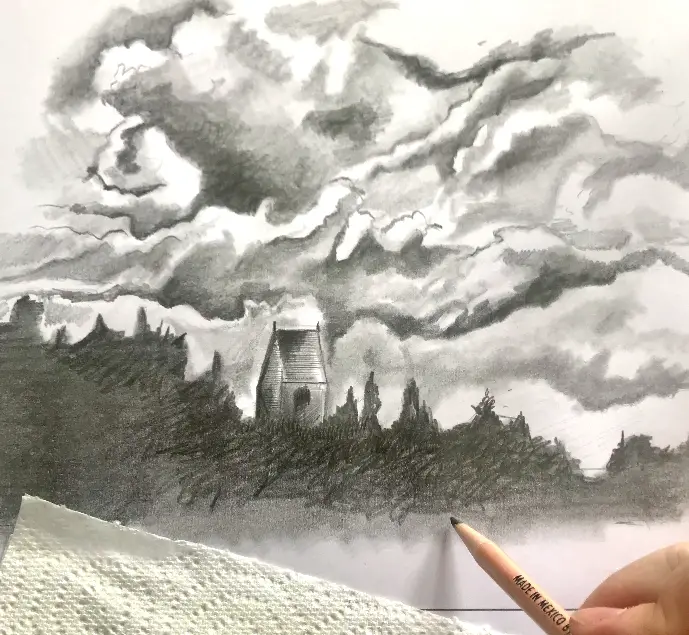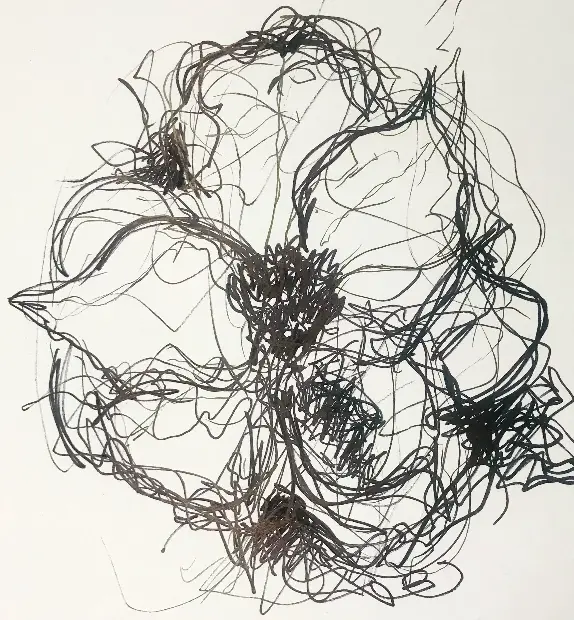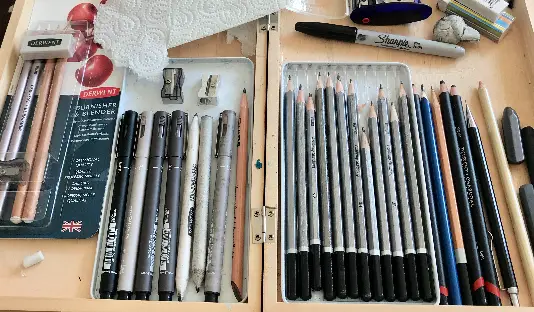Why do I suck at drawing? First of all, that's a very negative approach to take if you're trying to improve as an artist. Could you stand to improve as an artist? Who couldn't? But saying that you suck at drawing is little more than belittling yourself for no good reason.
Why Do You Struggle to Draw?
What you have to remember is that most artists are extremely hard on themselves. They see flaws in their work that most people would never notice. They focus on these flaws and obsess over them, then wrongly believe that they are failures as artists. The last thing you should do is to ever tell yourself that you suck at anything, especially art.
If you don't think that you're good enough, that's fine. In fact, that's the right attitude to have. If you think that you're perfect, you'll never get better as an artist. The key is to be constructive when you look at your work. Don't think that you suck, look for areas where you can get better and start working on it. Don't put yourself down.
Recognize your areas of opportunity, develop a plan to address those areas, and get to work. Art is about creativity, but there is a technical aspect to it as well. Being creative will only get you so far. You also need to develop techniques and learn about different methods you can use when rendering. If you find yourself struggling with your artwork, chances are pretty good that you haven't been at it long enough, or you haven't spent enough time practicing.
Please look at this drawing and sketching video course I have created. Use this link.
Related Posts You May Enjoy:
- How to Start Drawing Again
- Drawings not improving? Here's how to get better
- How To Make Your Drawings Look Less Stiff? A Practical Guide
What is the Best Way to Get Better at Drawing?
If you're looking for a secret trick that will let you get better at drawing, there's only one worth learning, and that's the need for practice. If you want to get better at anything in life, you have to practice. This is true for sports, for driving a car, for everything, including art. If the sketch was easy, then everyone would be great at it. But everyone isn't good at drawing, which means that it isn't easy, which means you'll have to work hard to get better at it.
Becoming better at drawing requires a combination of two things, natural talent and practice. If you have a lot of natural talent, that's great. Having a lot of natural talent will make it easier for you to improve. But what if you aren't the most naturally talented artist in the world? That's fine, too; it just means that you'll have to work harder to get to where you want to be.
Do You Want to Draw?
The most important question you have to ask yourself if you are trying to improve as an artist is whether or not you really want to draw. Do you just sketch here and there for fun? Do you find yourself doodling when you're bored, but other than that, you don't spend a lot of time honing your craft? If so, that doesn't sound like you want to draw. It sounds like you want something handed to you. It sounds like someone that isn't willing to work hard to get to where they want to be. If that sounds like you, then the answer is that you don't really want to draw.
Now, do you sketch, doodle, and spend hours a week rendering on top of that? Now, that sounds like someone that wants to draw. Do you take art classes because you enjoy them? Do you try practicing drawing different subjects with different types of media? Congratulations, you sound like someone that really wants to draw. The point is that you're willing to work for what you want. Are there some people born with a natural talent that lets them effortlessly excel as an artist? There are, but if you're reading this, you probably aren't one of them. Even if you are one of them, more practice never hurts anybody.
Will You Ever Get Better at Drawing?
Are you frustrated by a lack of progress with your artwork? If you aren't, then you probably aren't an artist! Artists are famously self-critical, so if you aren't happy with your work, then you're in good company. Now, if you aren't happy with your drawings and don't see any progress, that's different than simply not being happy about your drawings. What can cause a lack of progress with your drawings? It usually boils down to one culprit, a lack of practice. Wouldn't it be great if you could get out of bed one day and find that the pencil magically dances across the page for you and creates terrific drawings? It would be great, but it's not going to happen. You need to put in the time if you want your drawings to get better. It really is as simple as that.
Learn the Fundamentals of Drawing
When a construction crew starts putting up a building, they start by put up the ceiling first, right? Wait, that's not right. They put the walls up first, right? No, they don't do that either. What do they do first? They pour the foundation. Without a solid foundation, it's going to be impossible to build any type of lasting structure. What does this have to do with drawing? Well, everything.
As an artist, you don't start out painting the Mona Lisa. You start out by learning the fundamentals. You might think that you can skip a few steps, but doing so will only hurt you in the long run. You need to build a solid foundation by mastering the basics to move on to more challenging subjects and drawings. It's only natural to want to jump ahead, but you mustn't do. You need to build a foundation of skills to use those skills to create more advanced drawings.
How do you develop the fundamentals? Start out by sketching. What should you sketch? Everything that you can think of. Carry a sketchbook with you whenever you can. Sketch people when you're waiting at places. Sketch trees, cars, buildings, birds, basically if you can see it in the world around you, it should be in your sketchbook. The more you sketch different things, the more of a comfort level you'll develop as an artist drawing different types of subjects. Remember, all of the practice you are putting in now will only make you a better artist in the future.
Sketching is a great way to practice and develop your drafting skills, but it's far from the only thing you should be doing to advance as an artist. You also need to learn about perspective, shadows, and different rendering techniques. One of the best ways to get in the practice you need is to draw a still life. A still life may not be the most exciting subject to draw, but it is ideal for any artist trying to learn different techniques. When drawing a still life, you have total control over the situation. You can set up objects to draw in any arrangement you want, you can draw from any perspective that you want to, and you can set up the lighting however you want to. Drawing a still life may not be what you want to focus on, but it's a practice that can help you get your skills up to another level.
Reasons you May Not be Improving:
If you're looking for reasons why you may not be improving, there are quite a few that you need to consider. Before you start thinking about why you aren't improving, make sure that you keep a positive mindset about the situation. Your goal shouldn't be to beat yourself up; it should be to be constructive and look for positive ways to start improving your skill level.
Too Busy to Practice
The number one reason that you might not be improving as an artist is a lack of practice. What do you do if you're too busy to practice drawing? Well, you probably don't get any better. There probably will be times in your life when you won't have time to draw. Maybe it's a hectic time of the year at work, and you're working a lot of overtime. When you get off of work, you're probably too exhausted to draw. Maybe you have many personal or family issues right now that are taking up a lot of your time. No matter the reasons, if you don't have time to practice, you aren't going to get better.
If you don't have time to dedicate strictly to drawing, that's understandable, as long as it's not going to be a long-term issue. If you can't dedicate yourself to drawing regularly, you're not going to improve. Now, if whatever has you so busy is only going to be a temporary problem, you can still find time to practice by simply carrying a sketchbook with you. Even if you're too busy to sit down for a few hours a week, you can still find time to sketch. Sketch on your lunch break, or sketch for a few minutes before bed. The important thing is that you keep putting pencil or pen to paper regularly so that you can keep making progress.
Not Using the Right Side of Your Brain
Have you ever heard of the term right-brained or left-brained? Basically, a right-brained person is said to be more creative. A left-brained person is said to be more methodical and logical. Art is a creative process.
Are there times when a logical, methodical approach is beneficial? Yes, there are technical skills that you'll need to master to become a better artist. If you want your drawing skills to improve, then don't be afraid to act on instinct. Don't think about how something should look. Just start drawing.
Let your creative side take over, and don't worry about making mistakes. You should start every drawing as a light sketch, so do that and don't be afraid to mess up. That's what erasers are for! Allow your creativity to guide you, and then, when it's time to start rendering a drawing, you can start to use more technical skills.
Overthinking
Since art is a creative process, it's always best to let your instincts guide you. That doesn't mean that you don't need to take classes or practice technical skills. It means that you shouldn't discount your instincts when drawing.
Don't overthink things! If something feels right, then do it. If it doesn't work, that's fine. You can permanently erase mistakes, and if it comes to it, you can even start over. The best way to employ this approach is when sketching.
Sketch often, and when you sketch, don't think about it. Just do it. Just sketch and let your pen or pencil dance across the paper and let instinct guide you. It takes practice to become this free when drawing, but your work will benefit from it when you do.
Using an Eraser to Much
An eraser can be both an artist's best friend, as well as his worst enemy. Erasers are great for fixing mistakes, but they also force you to slow down. They force you to stop drawing from instinct and to take a more technical approach. The time for using erasers and embracing a more technical approach is during the final stages.
When you're rendering details and shadows, an eraser can help you to fix mistakes. But, during the initial stages of creation, put that eraser down! There's usually no need to erase when you sketch lightly because your overlying lines and shadows will cover up your sketch lines. You can always go back and erase and clean things up toward the end, but in the initial stages of a drawing, fight the temptation to reach for an eraser.
Not Using Variety of Materials
What's your favorite food? You have to be specific here. This has to be your favorite food from your favorite place. Now, do you have an answer in your head? Do you love that food? Great, now imagine eating that same meal every day for the rest of your life. That sounds pretty awful, doesn't it? What does this have to do with drawing?
A lot, actually, because if you use the same materials every time that you draw, you'll probably feel the same sense of boredom and tediousness that you would if you ate the same meal each day. Try drawing with new mediums, try drawing on new surfaces, and never stop experimenting! This will help your artwork to evolve, and it will help you to grow as an artist.
Create Art With My Favourite Drawing Resources
General Drawing Courses. I like Udemy if you want to develop your knowledge of drawing techniques. Udemy is an excellent choice due to its wide range of creative courses and excellent refund policy. They often have monthly discounts for new customers, which you can check here. Use my link.
Sketching and Collage. Take a look at this sketching resource I have created. Use this link.
Proko. Is one of my favorite teachers who surpasses in the teaching of Anatomy and Figure drawing. Prokos course breaks down the drawing of the human body into easy-to-follow components aiding the beginner to make rapid progress. For this, I really like Proko.
Art Easels. One of my favorite ways to draw is by using a drawing easel, which develops the skill of drawing on a vertical surface. The H frame easel is an excellent vertical way to add variety to the style and type of marks you create when using a drawing board.
To see all of my most up-to-date recommendations, check out this resource I made for you.





